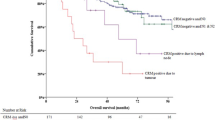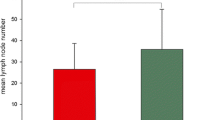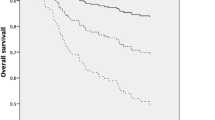Abstract
PURPOSE: The clinical significance and prognostic value of the histopathologic parameters used in both the Dukes and Jass classifications were evaluated to select those with an independent effect on survival after radical surgery for colorectal cancer. METHODS: The depth of local spread (limited to the bowel wall or extended beyond it), the number of metastatic lymph nodes (none, 1–4, more than 4), the character of the invasive margin (pushing or infiltrating), and the presence or absence of conspicuous peritumoral lymphocytic infiltration were assessed in 235 patients who had undergone radical resection for colorectal cancer. The influence of these variables on survival was studied by univariate and multivariate analysis. RESULTS: No significant difference in survival was found between patients with conspicuous peritumoral infiltrate and those without it; moreover, multivariate analysis failed to show any independent prognostic value for either lymphocytic infiltration or depth of local invasion. However, the character of the invasive margin and the number of metastatic lymph nodes were identified as the only variables with any independent importance on survival. Based on these data, a new prognostic model may be proposed; it uses the character of the infiltrative margin as a discriminating factor among patients within the lymph node-negative (Dukes A and B stages) and lymph node-positive (Dukes C1 and C2 subsets) groups. A good prognosis for Dukes A, B, and C1 patients was associated with pushing tumors; C1 and C2 patients with infiltrating tumors had a poor prognosis. On the whole, the new prognostic model has allowed for the placement of 59.6 percent of our patients into groups that provide a confident prognosis. The clinical outcome of Dukes A and B patients with infiltrating tumors is still uncertain. CONCLUSIONS: The character of the invasive margin is an important prognostic factor in colorectal cancer. The association of this parameter with the traditional Dukes classification may provide additional useful prognostic information and aid in the selection of those patients who could most benefit from adjuvant therapy.
Similar content being viewed by others
References
Dukes CE. The classification of cancer of the rectum. J Pathol Bacteriol 1932;35:323–32.
Gabriel WB, Dukes C, Bussey HJ. Lymphatic spread in cancer of the rectum. Br J Surg 1935;23:395–413.
Jass JR, Love S, Northover JM. A new prognostic classification for rectal cancer. Lancet 1987;1:1303–6.
Jass JR, Atkin WS, Cusick J,et al. The grading of rectal cancer: historical perspectives and a multivariate analysis of 447 cases. Histopathology 1986;10:437–59.
Kaplan E, Meier P. Non parametric estimation from incomplete observations. J Am Stat Assoc 1958;53:457–81.
Cox DR. Regression model and life tables. J R Stat Soc (B) 1972;34:187–220.
Gastrointestinal Tumor Study Group. Adjuvant therapy of colon cancer: results of a prospectively randomized trial. N Engl J Med 1984;310:737–43.
Wolmark N, Fisher B, Wieand HS. The prognostic value of the modifications of the Dukes' C class of colorectal cancer: an analysis of the NSABP clinical trials. Ann Surg 1986;203:115–22.
Fisher ER, Robinsky B, Sass R, Fisher B, and other NSABP collaborators. Relative prognostic value of the Dukes and the Jass systems in rectal cancer: findings from the National Surgical Adjuvant Breast and Bowel Projects (Protocol R-01). Dis Colon Rectum 1989;32:944–9.
Dukes CE, Bussey HJ. The spread of rectal cancer and its effect on prognosis. Br J Cancer 1958;12:309–20.
Carlon CA, Fabris G, Arslan-Pagnini C, Pluchinotta AM, Chinelli F, Carniato S. Prognostic correlations of operable carcinoma of the rectum. Dis Colon Rectum 1985;28:47–50.
Newland RC, Dent OF, Lyttle MN, Chapuis PH, Bokey EL. Pathologic determinants of survival associated with colorectal cancer with lymph node metastases: a multivariate analysis of 579 patients. Cancer 1994;73:2076–82.
Deans GT, Parks TG, Rowlands BJ, Spence RA. Prognostic factors in colorectal cancer. Br J Surg 1992;79:608–13.
Secco GB, Fardelli R, Campora E,et al. Prognostic value of the Jass histopathologic classification in left colon and rectal cancer: a multivariate analysis. Digestion 1990;47:71–80.
Jass JR, Morson BC. Reporting colorectal cancer. J Clin Pathol 1987;40:1016–23.
Dundas SA, Laing RW, O' Cathain A,et al. Feasibility of new prognostic classification for rectal cancer. J Clin Pathol 1988;41:1273–6.
Lanza G Jr, Borghi L, Ballotta MR,et al. Valutazione di parametri prognostici nel carcinoma del colon retto. I. Variabili istopatologiche. Pathologica 1992;84:131–53.
Shepherd NA, Saraga E-P, Love SB, Jass JR. Prognostic factors in colonic cancer. Histopathology 1989;14:613–30.
Ponz de Leon M, Sant M, Micheli A,et al. Clinical and pathologic prognostic indicators in colorectal cancer: a population-based study. Cancer 1992;69:626–35.
Chapman MA, Hardcastle JD, Armitage NC. Five-year prospective study of DNA tumor ploidy and colorectal cancer survival. Cancer 1995;76:383–7.
Pietra N, Sarli L, Sansebastiano G, Jotti GS, Peracchia A. Prognostic value of ploidy, cell proliferation kinetics, and conventional clinicopathologic criteria in patients with colorectal carcinoma: a prospective study. Dis Colon Rectum 1996;39:494–503.
References
Dukes CE. The classification of cancer of the rectum. J Pathol Bacteriol 1932;35:323–32.
Jass JR, Love S, Northover JM. A new prognostic classification for rectal cancer. Lancet 1987;1:1303–6.
Deans GT, Parks TG, Rowlands BJ, Spence RA. Prognostic factors in colorectal cancer. Br J Surg 1992;79:608–13.
Dundas SA, Laing RW, O'Cathain A,et al. Feasibility of new prognostic classification for rectal cancer. J Clin Pathol 1988;41:1273–6.
Author information
Authors and Affiliations
About this article
Cite this article
Cianchi, F., Messerini, L., Palomba, A. et al. Character of the invasive margin in colorectal cancer. Dis Colon Rectum 40, 1170–1176 (1997). https://doi.org/10.1007/BF02055162
Issue Date:
DOI: https://doi.org/10.1007/BF02055162




